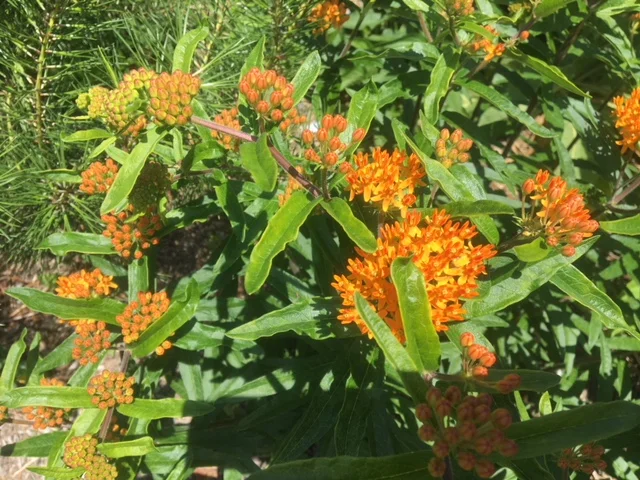Anne Raver: Our exciting and weird native plants
Butterfly weed.
From ecoRI News (ecori.org)
Last year around this time I wrote a piece for ecoRI News about pulling up a lot of exotic plants like azaleas and Japanese maples, and replacing them with native plants, like viburnums and dogwoods, to help out the birds and butterflies and all the other critters that depend upon native plants for food and shelter.
Now, three years into our native-plant garden, we are living among more than 50 native trees, dozens of native shrubs, and native perennials, wildflowers and grasses, many of which are spreading on their own. Tending our garden on a corner lot in Warren, R.I., we get a mix of reactions from our neighbors walking or driving slowly down the quiet streets.
“This is getting to be a jungle!” one woman observed, standing by the fence in late summer, when the tall perennials — Joe Pye-weed, queen of the prairie, rudbeckias and sunflowers — stretched way over her head.
“Isn’t it great?” I said. “Look at all the bees nuzzling those flowers.”
My neighbor likes things tidy. She cut down some big trees last year to plant more grass. And she keeps it cut short with her riding mower.
Other people love the profusion.
“Our mother asks us to slow down the car, so she can see what’s going on,” said a woman from next door. “We don’t know what the plants are, but they’re always doing something.”
A little boy, who trots down the street with his mother, heading for the playground, stops dead in his tracks when the big, yellow flowers of the prickly pear open.
“Don’t touch!” Mom warned, reminding him about the needles on the round-eared cactus. “How can that grow here? It looks like it should be in the desert.”
I tell her it’s native in New England, clear up to Maine.
But we don’t enjoy the bright flowers very long. The wild turkeys and their young stroll by to eat them.
After a few years, we’re seeing which native species love our sunny, dry acid soil, and which do not.
Butterfly weed thrives in local conditions.
The native butterfly weed (Asclepias tuberosa), a low mounding plant, with gorgeous bright-orange flowers, is spreading its seedlings all over. I couldn’t grow this beauty in my Maryland garden; the soil was just too heavy. Here, it grows like the “weed” that it is.
Its cousin, common milkweed (Asclepias syriaca) failed to flower, when I dug it up from a nearby ditch. But when I scattered seeds from another patch in fall 2016, it sprouted the next spring. And now, I see its thick, succulent leaves coming up along the fence, and in my vegetable garden.
On the other hand, swamp milkweed (Asclepias incarnata), which is a lovely soft pink, refuses to grow here. It needs damp soil to thrive.
Our eastern red cedars and pitch pines are loving it here, after we corrected a near-fatal mistake we made the first fall we were here. Thinking ourselves good gardeners, we put each little tree into its hole with a shovelful of compost. After a few weeks, the needles of the pitch pine turned yellow, the cedars turned a brittle brown.
We called the URI Gardening & Environmental Hotline (401-874-4836) and learned we had done exactly the wrong thing.
“Cedars and pines don’t like rich soil, they grow in sand dunes,” one of the master gardeners told us.
She didn’t think there was much we could do. “Sounds like they’re dying. Maybe better to start over.”
My never-say-die husband, Rock, rowed out to Rumstick Point and filled a few buckets with sand. We dug up the cedars and pines, and replanted with sand and a seaweed mulch.
The little trees slowly recovered, and now the cedars are over our heads and the quirky pitch pines are full of bright-green needles. As they get bigger, these trees provide nesting and shelter for wildlife, as well as food. Birds eat the blue-gray berries of the cedars; olive hairstreak caterpillars eat the needles. The seeds of the pitch pine cones sustain hungry pine grosbeaks and pine warblers in winter; pine elfin caterpillars thrive on its needles.
Every native plant in this garden feeds somebody. And it’s fun discovering just who they are.
As the Rhode Island Wild Plant Society’s annual sale approaches — June 2 from 9 a.m.-1 p.m. at URI East Farm, 1 East Farm Road, Kingston — I am wondering how many American hollies I can fit in my Honda Fit.
“No more trees!” Rock pleaded. (He’s counted more than 50, but they’re small.)
Not to worry, I tell him. I’m into groundcovers this year. The amazing common strawberry, which spreads rapidly, loves full sun, sandy soil, can take dry conditions, and produces delicious berries.
Red bearberry flourishes in dry, barren soil. It sports cute little bell-shaped flowers in spring, which turn to red berries for the birds (and bears) and its satiny leaves are evergreen.
Warren, R.I., resident Anne Raver has written about landscape and the environment for more than 30 years. She is an active member of the Rhode Island Wild Plant Society.
